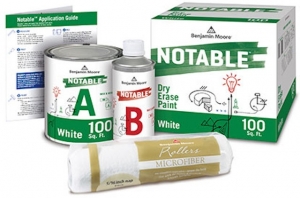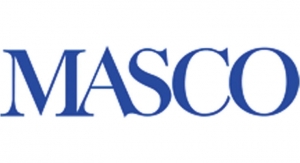Kerry Pianoforte, Editor11.06.17
The need for green coatings was created by the continuing trend toward reducing volatile organic compounds (VOCs) in decorative paint. VOC laws, which continue to evolve on both a global and regional level, and voluntary green building programs such as LEED – created by the U.S. Green Building Council – drive the demand for green coatings. Green coating products are in high demand by both professionals who want to comply with green building programs and DIYers who want to reduce their exposure to chemicals. The vast majority of paint and coatings companies now offer green coating options.
“Customers continue to show greater interest in products that are more environmentally conscious, and the needs of our customers remain a priority at PPG,” said Brian Osterried, product marketing manager, PPG. “Green practices have a permanent place in the industry and we continue to experience the advancement of low- and zero-VOC products. Professionals and do-it-yourselfers alike no longer need to trade quality and product performance with eco-friendly paint products.”
Benjamin Moore is dedicated to the green building movement and committed to developing products that are effective, safe and minimize impacts on the environment. “We have earned a number of third-party certifications for select paints and we work to ensure that these paints meet or exceed the strictest industry standards,” said a Benjamin Moore expert. “We are committed to the long term sustainability of the environment and the communities we live and work in.”
“Regulations have limited the kinds of coatings that manufacturers can offer, but consumer demand for ultra-low and zero-VOC paints has been driven primarily by desire for low-odor interior finishes,” said Robert Wendoll, director of environmental affairs at Dunn-Edwards. “This has been reinforced by voluntary green building standards that relate mostly to indoor air quality. Because demand for ultra-low and zero-VOC paints is growing, we consider them an important market segment.”
Product Offerings
PPG offers a number of low- and zero-VOC products across its PPG PAINTS, GLIDDEN paint and OLYMPIC paints brands. One example is PPG Paints PURE PERFORMANCE paint. “It is formulated to provide excellent hiding and ease of application in addition to low odor, zero VOCs and anti-microbial properties resulting from the incorporation of a preservative which inhibits the growth of mold and mildew on the dry paint film,” said Osterried. “PPG Paints Pure Performance paint is ideal for use in occupied areas such as hotel/motel resort properties, nursing homes, homes, schools, government facilities, retail space, office buildings, hospitals and apartments.
PPG Paints Pure Performance paint is GreenGuard Gold Certified and meets the emissions and materials disclosure criteria for LEED v4. It is important to note that colorants added to this base paint may increase VOC levels significantly depending on color choice.”
Benjamin Moore has been working to reduce VOC emissions from its paints by reducing the VOCs in the paints, reformulating various product lines and discontinuing high VOC product lines. Its lowest VOC paints include: Aura, Regal Select, ben, Natura, Waterborne Ceiling Paint, Eco-Spec WB and Ultra Spec 500.
Dunn-Edwards offers two zero-VOC interior paint lines, Everest and Spartazero. Both include a flat finish and several sheen levels in enamel. “We also have a variety of zero-VOC primers, including Ultra-Grip Select Multi-Purpose Primer, Vinylastic Select Interior Wall Sealer, and Interkote Premium Interior Undercoater,” Wendoll added.
“Our ultra-low-VOC paints (with VOC contents less than 50 g/L) are too numerous to list here.”
Paint manufacturers are tasked with formulating low- and zero-VOC products that meet or exceed their customers’ expectations. Although the current products on market perform well, there is still room for improvement.
According to Osterried, considerations that go into environmentally conscious paint products have evolved over the years. “As low- and zero-VOC paints are formulated,
it’s important to consider air quality, green building initiatives and certifications, carbon footprint and LEED v4 attributes while understanding product performance qualities that are important to professional and DIY painters.”
The scientists and technicians at Benjamin Moore work to continuously improve the application, quality and environmental performance properties of its products. For example, Benjamin Moore experts said it was the first company in the U.S. to introduce a waterborne tinting system with zero VOCs (according to EPA Method 24) in 2005. This system is known as the Gennex waterborne colorant system which revolutionized the industry and the growth of innovative products that feature both high performance and low emissions.
“The main technical challenges are in achieving good wet edge/open time and good dry film hardness,” noted Wendoll. “Resin selection is the most effective way to ensure good film hardness. Unfortunately, no truly effective non-VOC additives are currently available to improve wet edge/open time. We are hopeful that the industry will see some new developments in this area soon.”
There is strong demand for green coatings across all segments, but interior applications are driving demand the most.
Application areas vary based on the customer’s needs. “For example, if a professional contractor is interested in earning LEED v4 credits or painting an occupied area such as a nursing home or hotel, such products are likely a good fit,” noted Osterried. “Likewise, if a consumer is looking to paint a room in their house with high traffic, such as the kitchen or living room, it’s important to note the low-odor capabilities of many zero- and low-VOC products.”
Different facilities have different requirements when it comes to using green products. These requirements also vary by state regulations. Benjamin Moore reported that the demand for green products in both residential and commercial environments is steadily growing.
“We find strong demand for ultra-low and zero-VOC paints in all interior application categories,” said Wendoll. “Zero-VOC paints, in particular, are generally specified for institutional projects such as schools, hospitals, government offices and other public buildings. Zero-VOC paints are also a popular choice for homes where infants and children or adults with asthma and allergies reside.”
“Customers continue to show greater interest in products that are more environmentally conscious, and the needs of our customers remain a priority at PPG,” said Brian Osterried, product marketing manager, PPG. “Green practices have a permanent place in the industry and we continue to experience the advancement of low- and zero-VOC products. Professionals and do-it-yourselfers alike no longer need to trade quality and product performance with eco-friendly paint products.”
Benjamin Moore is dedicated to the green building movement and committed to developing products that are effective, safe and minimize impacts on the environment. “We have earned a number of third-party certifications for select paints and we work to ensure that these paints meet or exceed the strictest industry standards,” said a Benjamin Moore expert. “We are committed to the long term sustainability of the environment and the communities we live and work in.”
“Regulations have limited the kinds of coatings that manufacturers can offer, but consumer demand for ultra-low and zero-VOC paints has been driven primarily by desire for low-odor interior finishes,” said Robert Wendoll, director of environmental affairs at Dunn-Edwards. “This has been reinforced by voluntary green building standards that relate mostly to indoor air quality. Because demand for ultra-low and zero-VOC paints is growing, we consider them an important market segment.”
Product Offerings
PPG offers a number of low- and zero-VOC products across its PPG PAINTS, GLIDDEN paint and OLYMPIC paints brands. One example is PPG Paints PURE PERFORMANCE paint. “It is formulated to provide excellent hiding and ease of application in addition to low odor, zero VOCs and anti-microbial properties resulting from the incorporation of a preservative which inhibits the growth of mold and mildew on the dry paint film,” said Osterried. “PPG Paints Pure Performance paint is ideal for use in occupied areas such as hotel/motel resort properties, nursing homes, homes, schools, government facilities, retail space, office buildings, hospitals and apartments.
PPG Paints Pure Performance paint is GreenGuard Gold Certified and meets the emissions and materials disclosure criteria for LEED v4. It is important to note that colorants added to this base paint may increase VOC levels significantly depending on color choice.”
Benjamin Moore has been working to reduce VOC emissions from its paints by reducing the VOCs in the paints, reformulating various product lines and discontinuing high VOC product lines. Its lowest VOC paints include: Aura, Regal Select, ben, Natura, Waterborne Ceiling Paint, Eco-Spec WB and Ultra Spec 500.
Dunn-Edwards offers two zero-VOC interior paint lines, Everest and Spartazero. Both include a flat finish and several sheen levels in enamel. “We also have a variety of zero-VOC primers, including Ultra-Grip Select Multi-Purpose Primer, Vinylastic Select Interior Wall Sealer, and Interkote Premium Interior Undercoater,” Wendoll added.
“Our ultra-low-VOC paints (with VOC contents less than 50 g/L) are too numerous to list here.”
Paint manufacturers are tasked with formulating low- and zero-VOC products that meet or exceed their customers’ expectations. Although the current products on market perform well, there is still room for improvement.
According to Osterried, considerations that go into environmentally conscious paint products have evolved over the years. “As low- and zero-VOC paints are formulated,
it’s important to consider air quality, green building initiatives and certifications, carbon footprint and LEED v4 attributes while understanding product performance qualities that are important to professional and DIY painters.”
The scientists and technicians at Benjamin Moore work to continuously improve the application, quality and environmental performance properties of its products. For example, Benjamin Moore experts said it was the first company in the U.S. to introduce a waterborne tinting system with zero VOCs (according to EPA Method 24) in 2005. This system is known as the Gennex waterborne colorant system which revolutionized the industry and the growth of innovative products that feature both high performance and low emissions.
“The main technical challenges are in achieving good wet edge/open time and good dry film hardness,” noted Wendoll. “Resin selection is the most effective way to ensure good film hardness. Unfortunately, no truly effective non-VOC additives are currently available to improve wet edge/open time. We are hopeful that the industry will see some new developments in this area soon.”
There is strong demand for green coatings across all segments, but interior applications are driving demand the most.
Application areas vary based on the customer’s needs. “For example, if a professional contractor is interested in earning LEED v4 credits or painting an occupied area such as a nursing home or hotel, such products are likely a good fit,” noted Osterried. “Likewise, if a consumer is looking to paint a room in their house with high traffic, such as the kitchen or living room, it’s important to note the low-odor capabilities of many zero- and low-VOC products.”
Different facilities have different requirements when it comes to using green products. These requirements also vary by state regulations. Benjamin Moore reported that the demand for green products in both residential and commercial environments is steadily growing.
“We find strong demand for ultra-low and zero-VOC paints in all interior application categories,” said Wendoll. “Zero-VOC paints, in particular, are generally specified for institutional projects such as schools, hospitals, government offices and other public buildings. Zero-VOC paints are also a popular choice for homes where infants and children or adults with asthma and allergies reside.”



















